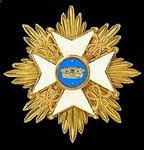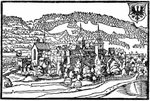The Reichsarmee were the underdogs of the armies of the Seven Years War. In theory, the Holy Roman Empire (which Voltaire quipped was not holy, Roman or an empire) could call on around 300 of its 2000 component states to provide men and/or money for the protection of the HRE. On paper the Reichs army amounted to 36,000 cavalry and 84,000 infantry but many states managed to avoid their theoretical obligations.
The aftermath of the battle of Kolin, 18th June 1757, when Frederick of Prussia was in difficulties, suddenly reminded the Reichs states of their obligation to protect the Empire. More than 30 sent contingents to work with the French army of Soubise against the Prussians.
The Imperial army of September 1757 totalled 25,000 men. The commander of the army was the Prince of Sachsen-Hildburghausen, whom Christopher Duffy memorably portrays in his book Prussia's Glory: Rossbach and Leuthen 1757* as an unsuccessful commander with a poor track record; a man with the upper strength of a gorilla and feeble legs, he was, sadly, completely without the diplomatic skills needed to command such a heterogeneous force as the Reichsarmee. His task also proved impossible in the face of the systemic mess that was the command structure of the Imperial Army. All operations had to be approved by Vienna and under him were 25 generals who stymied all his efforts to reorganise the army to make it fit to take the field.
Too many of the units, both cavalry and infantry, were made up of many small contingents; for example, the Hohenzollern Cuirassiers were made up of 61 distinct contingents. The single contingent units were undoubtedly the best; the Hessen-Darmstadt Regiment was of excellent quality. Other infantry regiments were made up of 6 to 42 contingents.Training was often non-existent.
French commander Soubise commented on what he saw as the quality of the Reichsarmee units; he rated Hesse-Darmstadt as excellent, seven units as good, six as adequate, seven as bad and Trier on its own as very bad indeed. Baden-Baden was one of the Bad units!
The artillery were in a terrible state, both of training and equipment, except for the Hessen-Darmstadt artillery. Clothing was often of terrible quality, as were weapons. Only some 10 per cent of muskets were in working order. The supply services matched the quality of everything else. As Mollo says, "The great mistake was made during the war of using the Imperial army in a combatant role, instead of for garrison or lines-of-communication duties."
Despite all these problems, elements of the Reichsarmee could, on occasion, perform very well. This was so at Freiberg in 1762, where Regiment Baden-Baden, along with Reichs Regiments Trier and Rodt plus some Reichs grenadiers, stopped a Prussian attack in its tracks for some hours before the battle was finally lost elsewhere on the battlefield. (I shall be doing the flags of Trier and Rodt as well as other Reichsarmee units' flags eventually.) There is a good account of the battle in Christopher Duffy's By Force of Arms, which is a large volume on the Austrian army in the Seven Years War.
Baden-Baden details:
2 battalions with 5 musketeer companies each and 1 grenadier company. Also had 2 3 pounder guns and a total strength of 1690 men. Unfortunately it consisted of men from 42 different estates.
It missed Rossbach but fought at Zinna (1st Torgau) in 1759 in the second line, where it fled along with the other Reichsarmee units. Freiberg was undoubtedly its moment of glory!
The flags are complicated and debatable; in my sheet I show the flags of the old regiment Baden-Baden which may have been carried in the Seven Years War; alternatively the flag below them shows the flag of former regiment Rodt which was renamed Baden-Baden in 1731 and whose colour may have been carried instead. As so often with the Reichsarmée, we cannot be certain.
And this was the uniform in 1756:
*I highly recommend this book; Helion have just republished it.





















